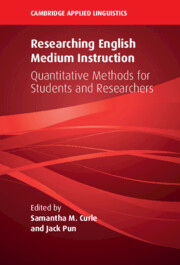Book contents
- Researching English Medium Instruction
- The Cambridge Applied Linguistics Series
- Researching English Medium Instruction
- Copyright page
- Dedication
- Contents
- Figures
- Tables
- Preface
- Acknowledgments
- Notes on Editors
- Notes on Contributors
- An Introduction to Researching English Medium Instruction Using Quantitative Research Methods
- Part I Theoretical Chapters
- Part II Empirical Chapters (Case Studies)
- 5 The Application of Partial Least Squares Structural Equation Modeling in Studies of EMI
- 6 Factor Analysis in Writing Research
- 7 Analyzing Questionnaire Data through Many-Facet Rasch Measurement: A Pilot Study of Students’ Attitudes toward EMI in the Chinese Higher Education Context
- 8 Questionnaire Development and Analysis in EMI Research
- 9 Effects of EMI on Learners’ Linguistic Development
- 10 Path Analysis of Science Learning in Hong Kong’s EMI Secondary Schools
- 11 Questionnaire Survey in Researching EMI
- 12 The Use of MANOVA in Analyzing the Effects of Gender on Perceived Difficulties in Speaking and Writing in a Hong Kong EMI University
- 13 Using a Longitudinal Quantitative Design to Investigate Student Transition from Secondary School to EMI Higher Education
- 14 A Corpus-Based Multidimensional Analysis of EMI University Classroom Discourse
- Index
- References
10 - Path Analysis of Science Learning in Hong Kong’s EMI Secondary Schools
from Part II - Empirical Chapters (Case Studies)
Published online by Cambridge University Press: 14 December 2024
- Researching English Medium Instruction
- The Cambridge Applied Linguistics Series
- Researching English Medium Instruction
- Copyright page
- Dedication
- Contents
- Figures
- Tables
- Preface
- Acknowledgments
- Notes on Editors
- Notes on Contributors
- An Introduction to Researching English Medium Instruction Using Quantitative Research Methods
- Part I Theoretical Chapters
- Part II Empirical Chapters (Case Studies)
- 5 The Application of Partial Least Squares Structural Equation Modeling in Studies of EMI
- 6 Factor Analysis in Writing Research
- 7 Analyzing Questionnaire Data through Many-Facet Rasch Measurement: A Pilot Study of Students’ Attitudes toward EMI in the Chinese Higher Education Context
- 8 Questionnaire Development and Analysis in EMI Research
- 9 Effects of EMI on Learners’ Linguistic Development
- 10 Path Analysis of Science Learning in Hong Kong’s EMI Secondary Schools
- 11 Questionnaire Survey in Researching EMI
- 12 The Use of MANOVA in Analyzing the Effects of Gender on Perceived Difficulties in Speaking and Writing in a Hong Kong EMI University
- 13 Using a Longitudinal Quantitative Design to Investigate Student Transition from Secondary School to EMI Higher Education
- 14 A Corpus-Based Multidimensional Analysis of EMI University Classroom Discourse
- Index
- References
Summary
Despite the enduring popularity of path analysis, there has been limited research in the context of English Medium of Instruction (EMI) to illustrate established theories. Moreover, researchers have yet to incorporate statistical data to refine the theoretical models and better elucidate the causal relationships between various factors that potentially influence students’ academic achievement. To fill this gap, this study aims to develop and analyze a well-fitted model that could account for contingent links between variables that directly and indirectly affect EMI students’ academic achievement in science. Drawing on survey data from eight EMI secondary schools in Hong Kong, the current study identified interplayed roles of students’ English proficiency, language use in science classroom, self-perceived English difficulty in the science classroom, and self-concept on science learning on science achievement by using path analysis – one of the structural equation modeling (SEM) models, which is also illustrated in Chapter 5 of the book.
Keywords
- Type
- Chapter
- Information
- Researching English Medium InstructionQuantitative Methods for Students and Researchers, pp. 168 - 182Publisher: Cambridge University PressPrint publication year: 2024

